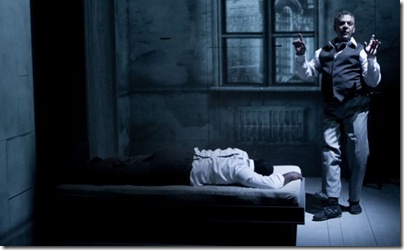Needles and Opium by Robert Lepage: Magic and Malaise Meet in This Revival From 20 Years Past.
Photo. Courtesy of the NAC English Theatre.
The English language version of Needles and Opium, conceived and directed by Robert Lepage, starring Marc Labrèche and Wellesley Robertson III , was both enchanting and disappointing, as Lepage’s work can often be. This was the first time I have seen one of his performances in English and I think the switching of perspectives between three time frames, added a dimension that dated the content of the play, especially the ironic interplay between English and French as the Americans show they cannot understand French and how that creates trouble for Robert, (Marc Labrèche), the writer who is doing voice overs of a film about Paris for an American Producer. That language irony corresponded to the state of mind of English/French relations 20 years ago, but that no longer has any importance. The language question is no longer creating anger, immigrants of all origins are the focus of current theatre about identity in Quebec (note the work by Mani Soleymanlou that has often come to the NAC). And no one cares who speaks with what accent. That appears in the sequences where the Americans are imposing difficult procedures for voice overs, causing trouble when Robert is working in the film studio . There you see that his dialogue, his content, the corporeal rhythm of the actor sometimes escape Lepage’s gaze and we are reminded that his work is at times “thin” and sometimes lacks substance .
However, what works most beautifully are the director’s use of film, lighting, music and visual elements, suggesting Paris in the 1950,s and how they blend, into images of Robert’s personal loss at the present, when he settles into the mythical space of Room no. 9 in a Parisian hotel called La Louisane, the place where Jean Paul Sartre et Simone de Beauvoir lived. The emotion is developed through the meeting of singer Juliette Greco, the darling of the post war existentialist movement and Miles Davis, the brilliant American trumpet player. The narrative of their liaison is given a deep emotional presentation through the sounds of Davis Trumpet, the black and White images of Paris that flow past, the descent of Davis (Wellesley Robertson III) into depression and drugs when he leaves Greco in Paris, returns to New York and loses control of his life. One very moving scene shows him improvising the background music for the film Ascenseur pour l’échafaud by French director Louis Malle, one of the young directors of the Cinema nouveau mouvement. We see a very young, lost and lonely Jeanne Moreau wandering through the streets of Paris as cars flash by and Davis’ trumpet pours out its heart. The actress incarnates Davis’ musical sounds that echo the musician’s loss. The actor playing Davis then collapses from an opium overdoes, as the “needles” move into the picture and take over the show. That period of drug overdose and sense of hopelessness defines Davis and echoes the feelings of Robert, the Quebec actor/poet who also comes to Paris to live a similar emotional experience many years later, which is to say, in the present.
It is all tied together by the figure of Jean Cocteau, poet, playwright, actor and visual artist, cineaste, who is in the airplane returning to Paris from New York where he has attended the launching of his feature film l’Aigle à deux têtes. Cocteau is already well known for his films that appeared in the 1940’s and conferred upon him the status of a creative icon in France. He floats over the whole world that emerges in this play, reading passages from his book Lettres aux Américains where he expresses his disappointment at the American way of life, adopting the figure of the Angel Gabriel, , floating in the sky as he announces the triumph of love, the revival of the artists In any case. Carl Fillion’s set revolving in the air, as it is transformed by arial and low angle shots to bring the characters into the picture from different perspectives is a piece of magical stage sculpture that brought much to the event.
The spatial and visual poetry intertwines networks of images, metaphors and themes that make poetic links across continents, a technique that has become Lepage’s artistic trademark. The show highlights the way Lepage fuses cinematography and stage design, creating illusions of space and time as bodies fly across the sky, swoop down enormous skyscrapers, peer out of buildings and crawl through walls as hotels rooms and inside landscapes melt, twist and split open while the human beings plunge and are transported through space. . Unfortunately, Marc Labrèche’s efforts to read Cocteau in English with a European French accent made his reading completely unintelligible and I lost Cocteau’s text. A language coach for the European french accent (in English ) was absolutely necessary. That left a big gap in my understanding of Cocteau’s literary text and at that moment, I wished I was watching the French language version because hearing Labrèche speak French (not English) with a European accent, would have been much easier to understand.
Needless to say, Needles and Opium is a discovery for those who have never seen Lepage’s work before but for those of us who know his work, next time we would probably make an effort to see the original version. Needles and Opium, written and directed by Robert Lepage, performed by Marc Labrèche and Wellesley Robertson III. English translator: Jenny Montgomery Set Designer: Carl Fillion Music and sound designer: Jean Sébastien Côté Lighting Designer: Bruno Matte Costume designer; Françoise Saint-Aubin Image designer: Lionel Arnould
